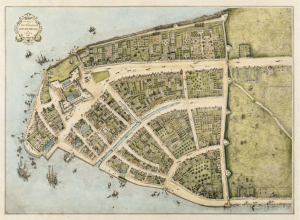This city goes back a ways. Its Golden Age was the 17th century, when the Dutch East India Company and Dutch West India Company ruled the waves and the colonies, and when most of Amsterdam (at least the parts featured on calendars and postcards, covering several square miles) was built. All those picturesque canal houses? 17th century.
The sun in the photo below shines on my favorite hotel, the Brouwer, built in 1652 along with most of the buildings alongside it and along this canal and the many dozens of other canal blocks shown in the 1663 map below.

Typical canal block, one of dozens.
Amsterdam in 1663

New Amsterdam (later New York) 1660

In Amsterdam during the 17th Century, civilization was flourishing, big time, not just in city size but civic culture. Many of the principles of liberty and freedom cooked up by the Dutch in that Golden Age were picked up 100 years later and brought back to America by John Adams, when he was here (1780-82) to raise money for our Revolutionary Army.
Those 17th century Dutch notions of liberty and freedom were also intertwines with notions of responsibility and accountability – accountability to others, to their fellow Amsterdammers. This was not a royal city with accountability to a crowned personage in a royal palace. And it was not ruled with religious institutional authority, not after occupying Spanish Catholics were thrown out by early Calvinist Protestants, allowing global mercantilism to flourish.
Responsibility toward others was neither liberal nor conservative, but primarily self-interested. It’s a lot cheaper, they reasoned, to build orphanages and apprenticeships than emergency rooms and prisons for those not prospering directly from life in the fast lanes of go-go multinational commerce.
They saw social responsibility toward others, expressed in municipal social policies managed by civilians, as the least they could do to preserve the qualities of freedom and liberty they clearly valued. They made self-interest work for the benefit of most everyone. And with all the money coming in from colonial plunder, they could afford to be generous, at least to their own (more on this later.)
A really good book on all this is is by Russell Shorto, then the Executive Director of the John Adams Institute here in Amsterdam, called “Amsterdam: A History of the World’s Most Liberal City.” A subtitle could be: “…and why Liberal isn’t what you think it means, especially if you’re a contemporary American Conservative.”
Advertisements Share this:





